THE PAYING BRAIN: THE CONSUMER EXPERIENCE IN THE BUYING PROCES
DOI:
https://doi.org/10.34630/tth.vi4.5684Keywords:
NEUROMARKETIG, Consumer Behavior, Consumer experience, BRAIN, THE BUYING PROCESSAbstract
In the Information Age, fleeting attention spans and fierce competition underscore the need to understand the complex workings of the human brain to stand out in the market. Neuromarketing emerges as an essential tool to grasp how sensory cues, emotions, and cognitive trends influence purchasing decisions. Studies show that these choices are often made subconsciously, influenced by emotional factors and unconscious memories. The use of neuroimaging techniques such as fMRI and EEG reveals that the brain plays a crucial role in shaping consumer preferences. For example, specific colors and aromas can trigger automatic responses. Therefore, understanding these mechanisms is critical for adjusting products, packaging, and marketing messages and developing more effective and impactful strategies aligned with consumer preferences.
References
Ariely, D., & Berns, G. S. (2010). Neuromarketing: the hope and hype of neuroimaging in business. Nature Reviews Neuroscience, 11(4), 284–292. https://doi.org/10.1038/nrn2795
Hennig-Thurau, T., Gwinner, K. P., & Gremler, D. D. (2002). Understanding Relationship Marketing Outcomes. Journal of Service Research, 4(3), 230–247. https://doi.org/10.1177/1094670502004003006
Kahneman, D. (2011). Thinking, Fast and Slow. Farrar, Straus and Giroux.
Kotler, P., Kartajaya, H., & Setiawan, I. (2017). Marketing 4.0 : moving from traditional to digital. John Wiley & Sons, Inc., Cop.
Krishna, A. (2012). An integrative review of sensory marketing: Engaging the senses to affect perception, judgment and behavior. Journal of Consumer Psychology, 22(3), 332–351. https://doi.org/10.1016/j.jcps.2011.08.003
Lee, N., Broderick, A. J., & Chamberlain, L. (2007). What is “neuromarketing”? A discussion and agenda for future research. International Journal of Psychophysiology : Official Journal of the International Organization of Psychophysiology, 63(2), 199–204. https://doi.org/10.1016/j.ijpsycho.2006.03.007
Lindstrom, M. (2008). Buyology: Truth and Lies About Why We Buy. Crown Business.
McClure, S. M., Li, J., Tomlin, D., Cypert, K. S., Montague, L. M., & Montague, P. Read. (2004). Neural Correlates of Behavioral Preference for Culturally Familiar Drinks. Neuron, 44(2), 379–387. https://doi.org/10.1016/j.neuron.2004.09.019
Morin, C. (2011). Neuromarketing: The New Science of Consumer Behavior. Society, 48(2), 131–135. springer. https://doi.org/10.1007/s12115-010-9408-1
Pine II, B., & Gilmore, J. (2002). The experience economy: work is theatre & every business a stage: goods and services are no longer enough. Journal of Revenue and Pricing Management, 1. https://www.researchgate.net/publication/292752215_The_experience_economy_work_is_theatre_every_business_a_stage_goods_and_services_are_no_longer_enough
Reichheld, F. F. (2003, December). The one number you need to grow. Harvard Business Review. https://hbr.org/2003/12/the-one-number-you-need-to-grow
Verhoef, P. C., Reinartz, W. J., & Krafft, M. (2010). Customer Engagement as a New Perspective in Customer Management. Journal of Service Research, 13(3), 247–252. https://doi.org/10.1177/1094670510375461
Knutson, B., Rick, S., Wimmer, G. E., Prelec, D., & Loewenstein, G. (2007). Neural Predictors of Purchases. Neuron, 53(1), 147–156. https://doi.org/10.1016/j.neuron.2006.11.010
Palmer, S. E., Schloss, K. B., & Sammartino, J. (2013). Visual Aesthetics and Human Preference. Annual Review of Psychology, 64(1), 77–107. https://doi.org/10.1146/annurev-psych-120710-100504
Mahdavi, M., Barbosa, B., Oliveira, Z., & Chkoniya, V. (2020). Sounds of scents: olfactory-auditory correspondences in the online purchase experience for perfume. Review of Business Management, 22(4), 836–853. https://doi.org/10.7819/rbgn.v22i4.4083
Wood, S. (2020, October 26). A Positive Buying Experience Is Crucial for Customer Happiness. Learn.g2.com. https://learn.g2.com/buying-experience
Downloads
Published
How to Cite
Issue
Section
License
Copyright (c) 2024 The Trends Hub

This work is licensed under a Creative Commons Attribution-NonCommercial-NoDerivatives 4.0 International License.


